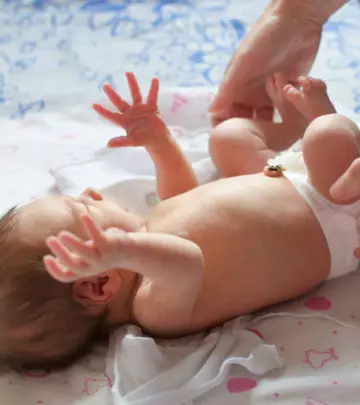
Image: Shutterstock
Let’s start by addressing unpopular opinions about parenting that, unfortunately, are very accurate. When you are handed over your tiny baby, you are suddenly expected to be an expert, but in reality, you just want to cry each time your baby cries! Even if you figured out the diaper changes, feeding, burping, and napping, there are still many things you can be clueless about. One of them is cleaning the belly button! We know it doesn’t sound tedious, but in reality, it feels like walking in a storm trying to keep a dandelion intact. So if your hands shake even at the thought of cleaning the fragile belly button of your newborn with the umbilical stump still plugged, know that you are not alone. Here in this article, we have written step-by-step directions on how to go about cleaning the belly button and the warning signs you should watch out for. Read on!
Step 1
Image: Shutterstock
- Collect the bath supplies you’ll require. It includes a clean dry towel, clothes, a fresh diaper, baby soap, cotton swabs, a sponge and a gentle baby cream.
- Don’t leave your kid unsupervised even for a minute while you arrange the bath supplies.
Note: Before your baby’s umbilical cord pops off on its own, you should sponge bathe them and not dunk them in water. Get a big, soft towel to put your baby on, or use their changing station.
Step 2
Image: Shutterstock
- Wash your hands well before touching the infant to avoid contaminating the umbilical cord.
- Rinse your hands properly after lathering them with antiseptic soap for at least 30 seconds.
Note: You should always wash your hands before and after changing their diaper.
Step 3
Image: Shutterstock
- Clean the area surrounding the umbilical plug’s base with a clean damp cloth.
- Warm water should be used to dampen the cloth and then be squeezed to remove excess moisture.
- Use a cotton swab to remove any dirt or debris from the skin near the plug and at its base.
- The rest of the cord should be kept dry.
Step 4
Image: Shutterstock
- Use gentle soap and water to wash away any grime.
- A mild baby cleanser diluted in water and a clean cotton swab is good enough for removing any dirt, feces, or urine from the region around the cord.
Step 5
Image: Shutterstock
- Towel dry the nearby areas of the stump thoroughly.
- Make sure the umbilical stump is fully dry by holding it in a clean towel.
- Avoid rubbing the area and instead pat it dry.
- A new diaper can be put on when the umbilical cord has dried completely.
- Keep the diaper’s top folded so it doesn’t rub against the baby’s umbilical cord and cause irritation.
Step 6
Image: Shutterstock
- Any concerns about the color or odor of the umbilical stump should be monitored closely.
- The umbilical stump usually falls off on its own during the first three weeks after birth (1).
- If your infant is sluggish, unhappy, or running a temperature when you’re cleaning the region around the cord, an infection has probably set in.
- A small amount of dried blood surrounding the stump is standard, but if you see any indications of infection, you should check with your pediatrician at once.
- Do not attempt to remove the umbilical cord prematurely.
Step 7
Image: Shutterstock
- While giving a bath after the stump dries and falls out, fill half the tub with lukewarm water.
- Keep your infant upright and supported in water no deeper than 3 to 4 inches if using a standard bathtub.
- Always have one hand on your baby when giving them a bath in the tub.
Step 8
Image: Shutterstock
- The navel and the surrounding area should be cleaned at last.
- You should start washing your baby’s hair, face, and body.
- At the very end of the bath, use a clean, damp washcloth and mild baby soap to cleanse the area around and inside the belly button.
- Warm water should be used to remove the soap residue.
Step 9
Image: Shutterstock
- Try to dry the navel region out wholly.
- Use a soft, dry cloth to pat your baby’s tummy and belly button.
- Do not scrub or even rub with a cloth. Instead, simply air it out when the excess water is soaked with a cloth.
- Once the region is dry, you can dress them.
Step 10
Image: Shutterstock
- Avoid experimenting with different cleansing creams on your newborn.
- Do not use lotions if your baby’s umbilical cord just came off naturally.
- Lotions can irritate or infect a still-healing belly button.
- Keep the area around the belly button clean and dry, and ensure it gets enough air.
Taking care of a newborn may feel like diffusing a bomb, but it doesn’t have to be that way. Believe it or not, newborns are actually stronger than they look. All you need is a little research and trust your parental instincts. If your baby doesn’t like anything, they will tell you through an ear-piercing cry. So, do you think this article will help you clean your baby’s navel more confidently? Let us know in the comments section!






















